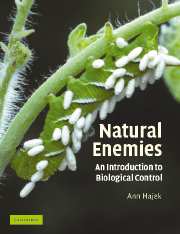Book contents
- Frontmatter
- Contents
- Preface
- Acknowledgments
- Introduction
- PART I Strategies for using natural enemies
- PART II Biological control of invertebrate and vertebrate pests
- PART III Biological control of weeds
- Chapter 13 Biology and ecology of agents used for biological control of weeds
- Chapter 14 Phytophagous invertebrates and vertebrates
- Chapter 15 Plant pathogens for controlling weeds
- PART IV Biological control of plant pathogens and plant parasitic nematodes
- PART V Biological control: concerns, changes, and challenges
- Glossary
- References
- Index
Chapter 15 - Plant pathogens for controlling weeds
Published online by Cambridge University Press: 05 June 2012
- Frontmatter
- Contents
- Preface
- Acknowledgments
- Introduction
- PART I Strategies for using natural enemies
- PART II Biological control of invertebrate and vertebrate pests
- PART III Biological control of weeds
- Chapter 13 Biology and ecology of agents used for biological control of weeds
- Chapter 14 Phytophagous invertebrates and vertebrates
- Chapter 15 Plant pathogens for controlling weeds
- PART IV Biological control of plant pathogens and plant parasitic nematodes
- PART V Biological control: concerns, changes, and challenges
- Glossary
- References
- Index
Summary
Just as microorganisms can decimate populations of insect pests, some microbe species are very effective at growing and reproducing using living plants as nutrient sources. Plant pathology is the study of microbes causing plant disease, with emphasis on how to control these microbes and manage their populations. However, some plant pathologists use their training to investigate the use of living microorganisms to control weedy plants. These plant pathologists are working to increase populations of plant pathogenic microbes, quite the opposite from the normal activities of plant pathologists.
Most major categories of microscopic organisms, viruses, bacteria, fungi, protists (a heterogeneous group of single-celled organisms), and nematodes, have members that are plant pathogens. However, the microorganisms most commonly selected for control of weeds are the fungi. As we will discuss, use of microbes for biological control of weeds has focused both on classical and inundative approaches to biological control. Different groups of fungi with very different attributes have been utilized for these very different biological control approaches.
Inundative biological control
The main goal of an inundative release is to attack an entire weed population with a single application of a pathogen without the assumption that the natural enemy will persist. This application strategy is similar to use of chemical herbicides and, in fact, the same application equipment can often be used for applying microbes that is used for applying chemical pesticides. Pathogens for weed control are generally applied annually, similar to applications of a chemical herbicide.
- Type
- Chapter
- Information
- Natural EnemiesAn Introduction to Biological Control, pp. 251 - 258Publisher: Cambridge University PressPrint publication year: 2004



